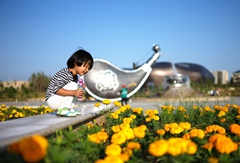Genghis Khan mausoleum protects customs, teaches history
Updated: 2017-09-05 By Song Mengxing (chinadaily.com.cn)  Print
Print 



The spring ritual for the hero dates back more than 700 years and is the largest Genghis Khan sacrifice activity on the Inner Mongolian prairie. It focuses on worshipping the sky and ancestors, as people pray for prosperity and safety.
The sacrifices include animals, milk and alcohol, conveying worship of ancestors and heroes.
The memorial ceremony has improved over the centuries and has become a main part of Genghis Khan’s sacrificial culture. It reveals the Mongolian ethnic group’s conventions, rites, beliefs, ideas, language and art.
It is the essence of the group’s traditional culture and has important value for the studies of Genghis Khan and his tomb, Mongolian history and culture, and even world history and culture, experts have said.
After Genghis Khan died, some loyal generals and their followers were chosen to guard his tomb and they became a new and sacred tribe in the history of the Mongols, called the Dalhut.
Kublai Khan, grandson of Genghis Khan, excused the tribe from cultivating, hunting or paying taxes. Instead, Dalhut people recite funeral orations their entire lives, guard Genghis Khan’s mausoleum and worship the great man.
The Dalhut tribe has guarded Genghis Khan’s tomb for nearly 800 years and its current population is about 2,000.
The Dalhut people have kept the memorial ritual for Genghis Khan in line with worship ceremonies for Mongol emperors that were formed in the 13th century.





 Ordos Impression
Ordos Impression Ordos WeChat
Ordos WeChat Ordos Reported
Ordos Reported


